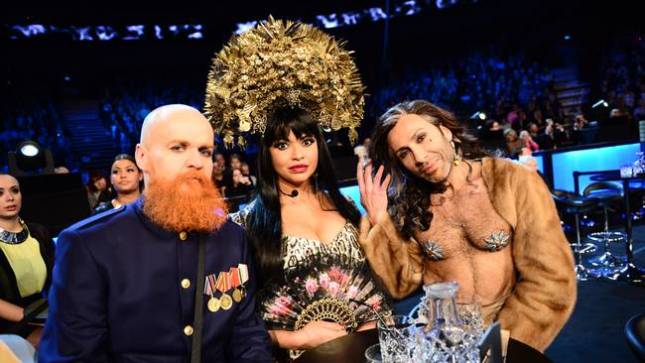As expected, Army of Lover’s contribution to Melodifestivalen the other day was a spectacle of rank. Alexander Bard in his trademark school uniform and red beard, Jean-Pierre Barda with nipple accessories and a partial lion (?) costume. La Camilla sat on a huge throne in a pompous queen outfit, flashing her underpants with a cross pictured in a “peccant” place (in reference to outfits from earlier hits, such as her nurse outfit in Obsession). The song and show itself was about, in short, having na-na-na-na-na-na, i.e. sex.
In the introduction, the band members proclaim (freely translated & emphasis added):
Today, many artists cozy up to the LGBT movement – Army of Lovers is LGBT!
–The Queer! The Lesbian! The Transvestite! We’re just a bit confused about who’s who…
In attempting to describe the whole thing, depictions such as bland and boring aren’t exactly the first that comes to mind. Rather, something like the opposite: flamboyant, ostentatious, provocative. Fawning for shock and awe. In fact, a suiting psychological description would be of it as histrionic. Histrionic behavior is characterized by exhibitionism, attention-seeking, superficiality, sexualization, lacking sense of boundaries etc. The underlying mechanisms hereto are traced from, among other factors, an under-developed or diffuse sense of self-identity[1]. Is there any correlation between this type of personality and LGBT culture?
An apparent paradox with the LGBT movement is that while it is purportedly about acceptance and tolerance of non-normative (sexual) identities – Accept yourself for who you really are! – elements within the very same movement, such as self-proclaimed LGBT artists, TV-personalities, even the Pride Parade etc, seem to be the source of some of the most notoriously materialistic, stereotype-adopting (usually of female attributes) and otherwise identity-externalizing displays you come across in society.
Perhaps this escape into exaggerated personas is not an act of actual identity formation, but rather a demonstration of emancipation: Look! I can be anyone I want and You can’t stop me! Like an obstinate adolescent acting to establish his identity with respect to his parents. Here, for the LGBT-person, the prejudiced and heteronormative society symbolizes the parents from which he emancipates. That would imply, however, that this “flamboyant period” of narcissistic exploration is transient and subsides as the identity solidifies…
…seeing that the Army of Lovers band members are in their 40’s and 50s, they’d seem either to be stuck in their personal development, or to be cynically exploiting the process.
***
[1] Histrionic Personality Disorder, Melissa Arthur LCSW MA
